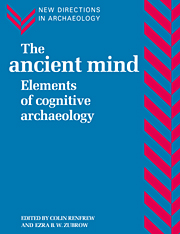Book contents
- Frontmatter
- Contents
- List of figures
- List of tables
- List of contributors
- Preface
- PART I INTRODUCTION
- PART II THE INTERDISCIPLINARY UNDERPINNING
- 2 Interpretation and testability in theories about prehistoric thinking
- 3 Archaeology and cognitive science
- 4 From domain specific to generalized intelligence: a cognitive interpretation of the Middle/Upper Palaeolithic transition
- 5 Are images animated? The psychology of statues in Ancient Greece
- PART III APPROACHES TO CULT PRACTICE AND TRANSCENDENTAL BELIEF SYSTEMS
- PART IV PREHISTORIC CONCEPTIONS OF SPACE AND TIME
- PART V THE MATERIAL BASIS OF COGNITIVE INFERENCE: TECHNOLOGY
- PART VI THE MATERIAL BASIS OF COGNITIVE INFERENCE: WRITING SYSTEMS
- PART VII CONCLUSION
- Index
5 - Are images animated? The psychology of statues in Ancient Greece
Published online by Cambridge University Press: 03 December 2009
- Frontmatter
- Contents
- List of figures
- List of tables
- List of contributors
- Preface
- PART I INTRODUCTION
- PART II THE INTERDISCIPLINARY UNDERPINNING
- 2 Interpretation and testability in theories about prehistoric thinking
- 3 Archaeology and cognitive science
- 4 From domain specific to generalized intelligence: a cognitive interpretation of the Middle/Upper Palaeolithic transition
- 5 Are images animated? The psychology of statues in Ancient Greece
- PART III APPROACHES TO CULT PRACTICE AND TRANSCENDENTAL BELIEF SYSTEMS
- PART IV PREHISTORIC CONCEPTIONS OF SPACE AND TIME
- PART V THE MATERIAL BASIS OF COGNITIVE INFERENCE: TECHNOLOGY
- PART VI THE MATERIAL BASIS OF COGNITIVE INFERENCE: WRITING SYSTEMS
- PART VII CONCLUSION
- Index
Summary
In the last years of the seventeenth century, the famous astronomer and antiquary of the Vatican, Francesco Bianchini, published La istoria universale provata conmonumenti e figurata con simboli (Universal history as documented by monuments and illustrated by symbols). In this book, for the first time in the history of archaeology, Bianchini (1747: 10) assumed:
le figure dei fatti ricoverate dei monumenti d'antichità oggidi conservate mi sono sembrate simboli insieme e prove dell'istoria.
(the representation of events observed on present-day monuments seem to me on the one hand symbols and on the other documents of history.)
He was, in fact, the first who had reflected on the role of symbols not only as figures of the past, but as a cognitive medium leading to the development of an archaeological theory.
This paper is a reflection on symbolism in Greek society (following the direction proposed by C. Renfrew), an attempt to investigate the way in which symbols were used. I shall be concerned with Greco-Roman society, from the seventh century BC to the third century AD, assuming that during these ten centuries a central body of theory and experience was elaborated about making and using images. I shall consider all symbolic artefacts used in either a cultic or cultural context for the very purpose of representation. This definition can already be read in Plato's work: eidola - is what is common to the various objects that we call by the name of images.
- Type
- Chapter
- Information
- The Ancient MindElements of Cognitive Archaeology, pp. 40 - 44Publisher: Cambridge University PressPrint publication year: 1994
- 7
- Cited by

